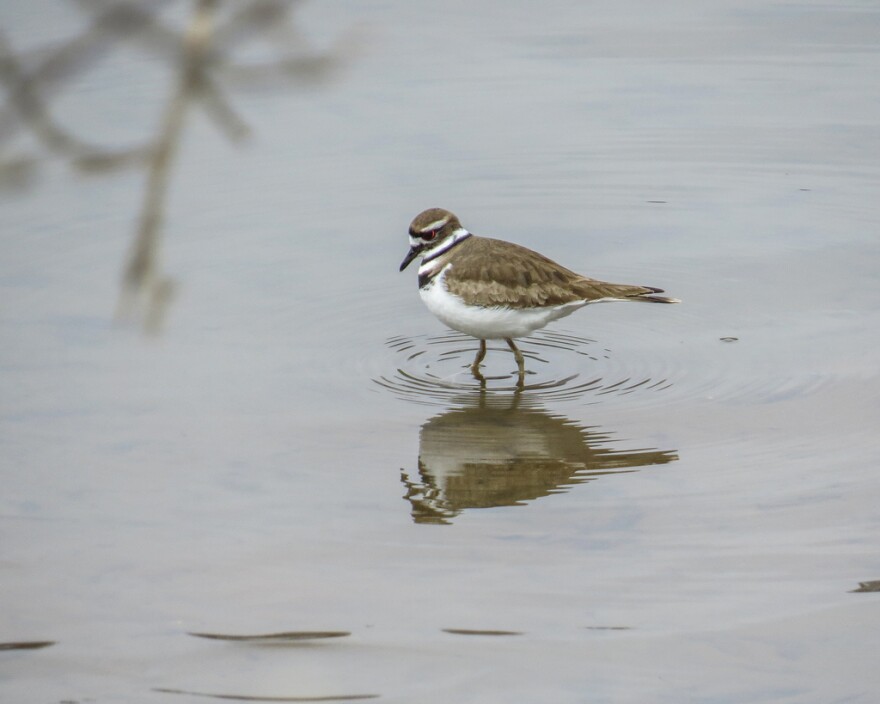Seasonal stasis
Staff phenologist John Latimer’s main takeaway from the past week is the marked pause in phenological development caused by the cold and snow.
“I can’t remember using the word ‘stasis’ so often in my notes as I did this past week and probably the week before,” he said. “...If you went back to March 1 and sort of compared the weather, then I would have expected the earliest ever Red-winged Blackbird, earliest ever robin, Killdeer, flickers. Those sorts of birds that all sort of come back about the same time. I would have expected [the earliest ever arrival]. But then, the cold weather slapped us back and we’ve sort of been sitting there idling along ever since.”
That sudden stillness was observed across much of the state. Lakes, at long last clear of ice, refroze while snow suddenly coated the formerly bare ground. The few buds that had already emerged stopped in their developmental tracks. Migratory birds, which had been flooding into the area at record-setting speed, hunkered down in thick cover or turned tail and flew south.
A peek at the forecast over the next week, however, shows that things will likely pick up again soon: get your binoculars and hand lens out, because it’s going to be a busy few months! (Charlie’s tip: download Seek and Merlin Bird ID to your phone. They’re incredibly helpful references!)

Hopkins' Law
I saw a sharp-lobed hepatica blooming in Marine on St. Croix on March 31. When do you think John will see one in Grand Rapids?
John Latimer, with the help of area K-12 teachers, endeavored to answer these sorts of questions for Minnesota. By comparing their own data, collected at locations throughout the state, with Hopkins Law – a theory* that spring moves across the landscape at a predictable speed – they built a map!
John used his own records, compared to the records of students across the state, to test this theory in Minnesota. Together, they made this map!
The person with the most data gets to be the center of the universe: therefore, you’ll find John Latimer/Grand Rapids as the seasonal ‘center’ of the map. Most locations south and west of Grand Rapids will have negative numbers, meaning spring will arrive to those locations 1-17 days earlier. North and east of Grand Rapids, spring arrives later by 1-16 days.
*A bit of background: By studying flowering dates of apple trees across the United States, Hopkins theorized that spring moves north at a rate of 17.25 miles/day, east 37 miles/day, and upward 100 feet of elevation/day.
I'll add a note of caution: Recent research suggests that Hopkin’s bioclimatic law is quite useful for mixed/deciduous forests, but less so for coniferous forests and grasslands. Your mileage may vary. Terms and conditions apply. See Momma Earth for details.

Using the map
Since I am in northern Washington County, we can predict that hepatica in my area will bloom 11 days earlier than in Grand Rapids. I saw my first hepatica flower on March 31. Let’s wait to discover what John finds around April 11!
On iNaturalist, I saw that my friends LeAnn and Ron saw their first Killdeer in Brainerd on March 30, 2024. That means that – if I had prepared to be in the right place, at the right time, with my eyes off my phone – I may have seen or heard one around March 24.
When you make sightings in your area, be sure to write them down with their date and location and let us know – I'd love to find out how the map works for you!
Topics
- Introduction (0:00-0:28)
- A seasonal pause/stasis (0:28-1:16, 9:52-10:37, 20:24-21:41)
- Precipitation report (1:16-2:37)
- Vernal ponds (2:20-6:05)
- Frogs (2:52-3:23)
- Dabbling or puddle ducks (3:23-6:05)
- Birds (3:23-11:13, 12:03-15:31)
- Dabbling or puddle ducks (3:23-6:05)
- Redpolls, goldfinches, Pine Siskins, Red- and White-breasted Nuthatches, Downy, Hairy, Red-bellied, and Pileated Woodpeckers (6:05-6:28)
- Northern Flickers and Yellow-bellied Sapsuckers (6:28-6:49)
- Nesting Canada Geese and Trumpeter Swans (6:49-7:51)
- Crows (7:51-8:48)
- First sightings of Turkey Vultures, robins, Red-winged Blackbirds (8:48-10:37)
- Ruffed Grouse eating aspen catkins (10:37-11:13)
- Bald Eagle nesting update – will they hatch over the next few days? (12:03-15:31)
- Plant development (11:05-12:03, 18:23-21:41)
- Aspen and pussywillow buds (11:05-11:56, 15:31-18:35)
- Pollen (11:39-12:03, 18:23- 18:35)
- What does it look like when a lilac breaks bud? (18:35-19:42)
- Speckled alder and nannyberry (19:42-20:24)
- Silver maple (20:24-21:41)
- Conclusion (21:41-22:35)
That does it for this week! For more phenology, <b>subscribe</b> to our Season Watch Newsletter or visit the Season Watch Facebook page.
Funding for this project was provided by the Minnesota Environment and Natural Resources Trust Fund as recommended by the Legislative-Citizen Commission on Minnesota Resources (LCCMR).








